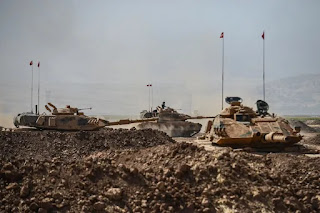Turkish Attacks in PKK Dominant Areas
Photo source: Arab News
By Naveed Qazi | Editor, Globe Upfront
By Naveed Qazi | Editor, Globe Upfront
Operation Claw-Lock is the successor of the similarly named joint air and ground operations Claw-Lightning and Claw-Thunderbolt in 2021, and Claw-Eagle and Claw-Tiger in 2020.
The Turkish military is carrying out helicopter-borne commando raids on mountains and into caves. Unlike past operations that concluded by winter, Turkish forces, in these new operations, are making gains all year round, through the establishment of an increasing number of military outposts, and forward operating bases in strategically important areas. Although these operations have failed to rout out PKK in the Qandil stronghold, they have nevertheless put unprecedented pressure on the group.
Turkey is also alleged to have used chemical weapons in its campaigns against the Kurdish Workers Party (PKK) at least '164 times', according to Zagros Hiwa, a spokesperson of the Union of Communities of Kurdistan (KCK).
It was in July 2015 when the ceasefire between Turkey and PKK completely collapsed. The ceasefire first happened in 2013. Then, in 2016, Turkey's Kurdish-majority southeast experienced levels of violence not seen since the 1990s. The PKK fought against the Turkish security forces in urban centres. It made Turkey impose punishing long curfews in entire city districts, and large swathes of Kurdish-majority towns and cities were reduced to a heap of debris.
In May 2021, Iraqi Kurds also expressed their frustration when satellite images revealed that Turkey was deforesting the Iraqi Kurdistan border with Turkey. The aim had been to build roads for military posts. With time, Turkey has established at least forty military bases and outposts throughout the autonomous Iraqi Kurdish region as part of this effort.
Kurdish analyst Ceng Sagnic recently pointed out that the conflict has recently reached ‘topographically difficult regions’ in the autonomous Kurdish region that has been under undisputed PKK control for over 25 years.
Abdulla Hawez, another Kurdish analyst, noted that Turkish positions along the border suggest that the Turkish army is gradually creating what appears to be a belt throughout its border with Iraq. Such a 'belt', most of it, would undoubtedly constrain PKK movements between Iraqi Kurdistan, Turkey and possibly Syria as well.
After the launch of Claw-Lightning and Thunderbolt, Turkey's interior ministry announced that the military would establish a new base in Iraqi Kurdistan's Metina region. The very next day, the Turkish minister of defence made an unscheduled visit to Turkish troops based in Iraqi Kurdistan, briefly raising eyebrows in Baghdad.
Turkey also opposed the PKK forming what it called a ‘terror corridor’ across northern Syria. By 2015, the SDF controlled two-thirds of northern Syria’s border regions, extending from the Iraqi border in the east to the east bank of the Euphrates River.
There also might be a renewed offensive by Turkey in the Sinjar region of northern Iraq, where IS infamously subjected the Yazidi religious minority to a notorious campaign of genocide beginning in August 2014. The PKK intervened against Islamic State and saved thousands of Yazidis in the process. Turkey then tried to retain its presence there amid operations of Sinjar Protection Units. It has repeatedly condemned the PKK's presence there for years now, invariably pledging not to allow a ‘second Qandil’ to be established there. Sinjar is strategically important for the PKK, and its Syrian wing, since it enables its fighters to transit overland from Qandil to northeast Syria.
Shortly after Turkey conquered Afrin, Turkey even upped the pressure against the PKK in Iraqi Kurdistan, beginning a string of extensive air and ground operations that continues to the present day. Dubbed 'Tigris Shield' by Turkish media, it was the most significant Turkish operation in Iraqi Kurdistan since the short-lived Operation Sun in late February 2008, just over a decade earlier. In the following years, Turkey also expanded its networks of bases and outposts, establishing military bases in the mountains of Iraqi Kurdistan's Erbil province for the first time. It also assassinated high-profile opponents such as PKK member Zaki Shingali in Sinjar in an air or drone strike on his convoy.
Turkey, time and again, is also using its militia proxies. It uses them to invade a swath of territory between Kobani and Jazira, occupying the cities of Tal Abyad and Ras al-Ain. Turkey stopped its offensive after reaching separate ceasefire negotiations with Russia and the United States but retained its hold of the new areas it had invaded.
By 2020, data showed that 77 per cent of clashes between the Turkish military and the PKK were taking part in Iraq rather than southeast Turkey, the site of the bloody urban battles of 2016. ISIS offensives have also played their part in the war, especially in the region separating the Syrian Kurdish canton of Kobani from the north-western enclave of Afrin.
Turkish Defence Minister Hulusi Akar once said that their operations are based on a strategy that will completely lock the borderline between Iraq and Turkey to the PKK. In other words, it also means that an independent greater socialist Kurdistan, even an autonomous state will leave Erdogan uneasy. Thus, he doesn’t want Kurdistan to integrate. By also attacking Hashd Al Shaabi (PMF) a pro-Iranian armed group, Turkey sent a clear message to the Shia factions to remain outside of Turkey’s political game in Iraq.




Comments
Post a Comment
Advice from the Editor: Please refrain from slander, defamation or any kind of libel in the comments section.